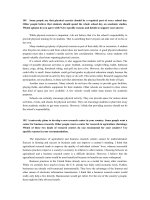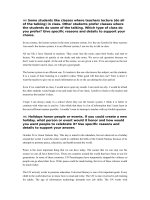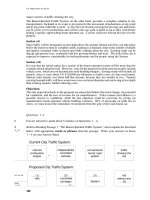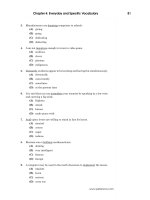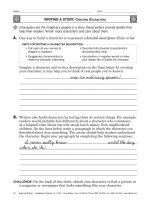economic english 10 pptx
Bạn đang xem bản rút gọn của tài liệu. Xem và tải ngay bản đầy đủ của tài liệu tại đây (142.38 KB, 6 trang )
Molecular Basis of Heredity
What an organism looks like and how it functions is
determined largely by its genetic material. The basic
principles of heredity were developed by Gregor Mendel,
who experimented with pea plants in the 19th century.
He mathematically analyzed the inherited traits (such as
color and size) of a large number of plants over many
generations. The units of heredity are genes carried on
chromosomes. Genetics can explain why children look
like their parents, and why they are, at the same time, not
identical to the parents.
Phenotype and Genotype
The collection of physical and behavioral characteristics
of an organism is called a phenotype. For example, your
eye color, foot size, and ear shape are components of
your phenotype. The genetic makeup of a cell or organ-
ism is called the genotype. The genotype is like a cook-
book for protein synthesis and use. Phenotype (what an
organism looks like or how it acts) is determined by the
genotype (its genes) and its environment. By environ-
ment, we don’t mean the Earth, but the environment
surrounding the cell or organism. For example, hor-
mones in the mother’s body can influence the gene
expression.
Reproduction
Asexual reproduction on the cellular level is called mito-
sis. It requires only one parent cell, which, after exactly
multiplying its genetic material, splits in two. The result-
ing cells are genetically identical to each other and are
clones of the original cell before it split.
Sexual reproduction requires two parents. Most cells
in an organism that reproduces sexually have two copies
of each chromosome, called homologous pairs—one
from each parent. These cells reproduce through mitosis.
Gamete cells (sperm and egg cells) are exceptions. They
carry only one copy of each chromosome, so that there
are only half as many chromosomes as in the other cells.
For example, human cells normally contain 46 chromo-
somes, but human sperm and egg cells have 23 chro-
mosomes. At fertilization, male and female gametes
(sperm and egg) come together to form a zygote, and the
number of chromosomes is restored by this union. The
genetic information of a zygote is a mixture of genetic
information from both parents. Gamete cells are manu-
factured through a process called meiosis, whereby a cell
multiples its genetic material once, but divides twice,
producing four new cells, each contains half the number
of chromosomes present in the original cell before divi-
sion. In humans, gametes are produced in testes and
ovaries. Meiosis causes genetic diversity within a species
by generating combinations of genes different from
those present in the parents.
– LIFE SCIENCE–
235
2
2
2
2
2
2
2
2
2
2
2
Cytoplasm
Endoplasmic
reticulum
Plasma
membrane
Nucleolus
Nucleus
Vacuole
Cell wall
Ribosomes
Mitochondria
Centriole
Chloroplast
Lysosome
Animal Cell
Plant Cell
Golgi
complex
Alleles
Alleles are alternative versions of the same gene. An
organism with two copies of the same allele is homozy-
gous, and one with two different alleles is heterozygous.
For example, a human with one gene for blue eyes and
one gene for brown eyes is heterozygous, while a human
with two genes for blue eyes or two genes for brown eyes
is homozygous. Which of the two genes is expressed is
determined by the dominance of the gene.
An allele is dominant if it alone determines the phe-
notype of a heterozygote. In other words, if a plant has a
gene for making yellow flowers and a gene for making
red flowers, the color of the flower will be determined by
the dominant gene. So if the gene for red flowers is dom-
inant, a plant that has both the gene for red and the gene
for yellow will look red. The gene for yellow flowers in
this case is called recessive, as it doesn’t contribute to the
phenotype (appearance) of a heterozygote (a plant con-
taining two different alleles). The only way this plant
would make yellow flowers is if it had two recessive
genes—two genes both coding for yellow flowers.
For some genes, dominance is only partial and two
different alleles can be expressed. In the case of partial
dominance, a plant that has a gene that codes for red
flowers and a gene that codes for white flowers would
produce pink flowers.
A Punnett square can be used to represent the possi-
ble phenotypes that offspring of parents with known
genotypes could have. Take the example with the yellow
and red flower. Let’s label the gene for the dominant red
gene as R and the gene for yellow flowers as r. Cross a
plant with yellow flowers (genotype must be rr) with a
plant with red flowers and genotype Rr. What possible
genotypes and phenotypes can the offspring have? In a
Punnett square, the genes of one parent are listed on one
side of the square and the genes of the other parent on
the other side of the square. They are then combined in
the offspring as illustrated here:
The possible genotypes of the offspring are listed
inside the square. Their genotype will be either Rr or rr,
causing them to be either red or yellow, respectively.
Sex Determination
In many organisms, one of the sexes can have a pair of
unmatched chromosomes. In humans, the male has an X
chromosome and a much smaller Y chromosome, while
the female has two X chromosomes. The combination
XX (female) or XY (male) determines the sex of
humans. In birds, the males have a matched pair of sex
chromosomes (WW), while females have an unmatched
pair (WZ). In humans, the sex chromosome supplied by
the male determines the sex of the offspring. In birds, the
female sex chromosome determines the sex.
Plants, as well as many animals, lack sex chromo-
somes. The sex in these organisms is determined by other
factors, such as plant hormones or temperature.
Identical twins result when a fertilized egg splits in
two. Identical twins have identical chromosomes and can
be either two girls or two boys. Two children of different
sex born at the same time can’t possibly be identical
twins. Such twins are fraternal. Fraternal twins can also
be of the same sex. They are genetically not any more
alike than siblings born at different times. Fraternal twins
result when two different eggs are fertilized by two dif-
ferent sperm cells.
When meiosis goes wrong, the usual number of chro-
mosomes can be altered. An example of this is Down’s
syndrome, a genetic disease caused by the presence of an
extra chromosome.
Changes in DNA (mutations) occur randomly and
spontaneously at low rates. Mutations occur more fre-
quently when DNA is exposed to mutagens, including
ultraviolet light, X-rays, and certain chemicals. Most
mutations are either harmful to or don’t affect the organ-
ism. In rare cases, however, a mutation can be beneficial
to an organism and can help it survive or reproduce.
Ultimately, genetic diversity depends on mutations, as
mutations are the only source of completely new genetic
material. Only mutations in germ cells can create the
variation that changes an organism’s offspring.
Plant
rr
RRr Rr
rrr rr
Plant
– LIFE SCIENCE–
236
Biological Evolution
Mutations cause change over time. The result of a series
of such changes is evolution, or as Darwin put it,
“descent with modification.” The great diversity on our
planet is the result of more than 3.5 billion years of evo-
lution. The theory of evolution argues that all species on
Earth originated from common ancestors.
Evidence for Evolution
Several factors have led scientists to accept the theory of
evolution. The main factors are described here.
■
Fossil record. One of the most convincing forms
of evidence is the fossil record. Fossils are the
remains of past life. Fossils are often located in
sedimentary rocks, which form during compres-
sion of settling mud, debris, and sand. The order
of layers of sedimentary rock is consistent with
the proposed sequence in which life on Earth
evolved. The simplest organisms are located at
the bottom layer, while top layers contain increas-
ingly complex and modern organisms, a pattern
that suggests evolution.
■
Biogeography. Another form of evidence comes
from the fact that species tend to resemble neigh-
boring species in different habitats more than
they resemble species in similar, but far away,
habitats.
■
Comparative anatomy. Comparative anatomy
provides us with another line of evidence. It
refers to the fact that the limb bones of different
species, for example, are similar. Species that
closely resemble one another are considered more
closely related than species that do not resemble
one another. For example, a horse and a donkey
are considered more closely related than a horse
and a frog. Biological classifications (kingdom,
phylum, class, order, family, genus, and species)
are based on how organisms are related. Organ-
isms are classified into a hierarchy of groups and
subgroups based on similarities that reflect their
evolutionary relationships.
■
Embryology. Embryology provides another form
of evidence for evolution. Embryos go through
the developmental stages of their ancestors to
some degree. The early embryos of fish, amphib-
ians, reptiles, birds, and mammals all have com-
mon features, such as tails.
■
Comparative molecular biology. Comparative
molecular biology confirms the lines of descent
suggested by comparative anatomy and fossil
record.
Darwin also proposed that evolution occurs gradually,
through mutations and natural selection. He argued that
some genes or combinations of genes give an individual a
survival or reproductive advantage, increasing the chance
that these useful combinations of genes will make it to
future generations. Whether a given trait is advantageous
depends on the environment of the organism. Natural
selection is only one of several mechanisms by which
gene frequency in a population changes. Other factors
include mating patterns and breeding between popula-
tions.
Interdependence of Organisms
The species in communities interact in many ways. They
compete for space and resources, and they can be related
as predator and prey, or as host and parasite.
Plants and other photosynthetic organisms harness
and convert solar energy and supply the rest of the food
chain. Herbivores (plant eaters) obtain energy directly
from plants. Carnivores are meat eaters and obtain
energy by eating other animals. Decomposers feed on
dead organisms. The flow of energy can then be repre-
sented as follows:
Sun → Photosynthetic organisms →
Herbivores → Carnivores → Decomposers
The food chain is not the only example of the inter-
dependence of organisms. Species often have to compete
for food and space, so that the increase in population of
one can cause the decrease in population of the other.
Organisms also may have a symbiotic relationship
(live in close association), which could be classified as
parasitism, mutualism, or commensalism. In a parasitic
relationship, one organism benefits at the expense of the
other. Commensalism is symbiosis in which one organ-
ism benefits and the other is neither harmed nor
rewarded. In mutualism, both organisms benefit.
Under ideal conditions, with ample food and space
and no predators, all living organisms have the capacity
to reproduce to infinite number. However, resources are
limited, limiting the population of a species.
– LIFE SCIENCE–
237
Humans probably come closest to being a species with
seemingly infinite reproductive capacity. Our population
keeps increasing. Our only danger seems to come from
viruses and bacteria, which at this point, we more or less
have under control. When we need more food, we grow
more, and when we need more space, we clear some by
killing off other biomes. By doing this, humans modify
ecosystems and destroy habitats through direct harvest-
ing, pollution, atmospheric changes, and other factors.
This attitude is threatening current global stability and
has the potential to cause irreparable damage.
Behavior of Organisms
Even the most primitive unicellular organisms can act to
maintain homeostasis. More complex organisms have
nervous systems. The simplest organism found to have
learning capability is a worm, suggesting a more complex
nervous system. The function of the nervous system is
collection and interpretation of sensory signals as trans-
mission of messages from the center of the nervous sys-
tem (brain in humans) to other parts of the body. The
nervous system is made of nerve cells, or neurons, which
conduct signals in the form of electrical impulses. Nerve
cells communicate by secreting excitatory or inhibitory
molecules called neurotransmitters. Many legal and ille-
gal drugs act on the brain by disrupting the secretion or
absorption of neurotransmitters.
Many animals have sense organs that enable them to
detect light, sound, and specific chemicals. These organs
provide the animals with information about the outside
world. Animals engage in innate and learned social
behavior. These behaviors include hunting or searching
for food, nesting, migrating, playing, caring for their
young, fighting for mates, and fighting for territory.
Plants also respond to stimuli. They turn toward the
sun and let their roots run deeper when they need water.
– LIFE SCIENCE–
238
E
ARTH AND SPACE science are concerned with the formation of the Earth, the solar system and the
universe, the history of Earth (its mountains, continents and ocean floors), the weather and seasons
on Earth, the energy in the Earth system, and the chemical cycles on Earth.
Energy in the Earth Systems
Energy and matter can’t be created or destroyed. But energy can change form and travel great distances.
Solar Energy
The sun’s energy reaches our planet in the form of light radiation. Plants use this light to synthesize sugar mol-
ecules, which we consume when we eat the plants. We obtain energy from the sugar molecules and our bodies
use it. Ultimately, our energy comes from the sun. The sun also drives the Earth’s geochemical cycles, which will
be discussed in the next section.
The sun heats the Earth’s surface and drives convection within the atmosphere and oceans, producing winds
and ocean currents. The winds cause waves on the surface of oceans and lakes. The wind transfers some of its
energy to the water, through friction between the air molecules and the water molecules. Strong winds cause large
CHAPTER
Earth and Space
Science
HUMANS HAVE always wondered about the origin of the Earth
and the universe that surrounds it. What kinds of matter and energy are
in the universe? How did the universe begin? How has the Earth
evolved? This chapter will answer these fundamental questions and
review the key concepts of Earth and space science.
25
239
waves. Tsunamis, or tidal waves, are different. They result
from underwater earthquakes, volcanic eruptions, or
landslides, not wind.
Energy from the Core
Another source of Earth’s energy comes from Earth’s
core. We distinguish four main layers of Earth: the inner
core, the outer core, the rocky mantle, and the crust. The
inner core is a solid mass of iron with a temperature of
about 7,000° F. Most likely, the high temperature is
caused by radioactive decay of uranium and other
radioactive elements. The inner core is approximately
1,500 miles in diameter. The outer core is a mass of
molten iron that surrounds the solid inner core. Electri-
cal currents generated from this area produce the earth’s
magnetic field. The rocky mantle is composed of silicon,
oxygen, magnesium, iron, aluminum, and calcium and is
about 1,750 miles thick. This mantle accounts for most
of the Earth’s mass. When parts of this layer become hot
enough, they turn to slow moving molten rock, or
magma. The Earth’s crust is a layer from four to 25 miles
thick, consisting of sand and rock.
The upper mantle is rigid and is part of the litho-
sphere (together with the crust). The lower mantle flows
slowly, at a rate of a few centimeters per year. The crust
is divided into plates that drift slowly (only a few cen-
timeters each year) on the less rigid mantle. Oceanic
crust is thinner than continental crust.
This motion of the plates is caused by convection
(heat) currents, which carry heat from the hot inner
mantle to the cooler outer mantle. The motion results in
earthquakes and volcanic eruptions. This process is
called plate tectonics.
Tectonics
Evidence suggests that about 200 million years ago, all
continents were a part of one landmass, named Pangaea.
Over the years, the continents slowly separated through
the movement of plates in a process called continental
drift. The movement of the plates is attributed to con-
vection currents in the mantle. The theory of plate tec-
tonics says that there are now twelve large plates that
slowly move on the mantle. According to this theory,
earthquakes and volcanic eruptions occur along the lines
where plates collide. Dramatic changes on Earth’s land-
scape and ocean floor are caused by collision of plates.
These changes include the formation of mountains and
valleys.
Geochemical Cycles
Water, carbon, and nitrogen are recycled in the bios-
phere. A water molecule in the cell of your eye could have
been, at some point, in the ocean, in the atmosphere, in
a leaf of a tree, or in the cell of a bear’s foot. The circula-
tion of elements in the biosphere is called a geochemical
cycle.
Water
Oceans cover 70% of the Earth’s surface and contain
more than 97% of all water on Earth. Sunlight evapo-
rates the water from the oceans, rivers, and lakes.
Living beings need water for both the outside and the
inside of their cells. In fact, vertebrates (you included)
are about 70% water. Plants contain even more water.
Most of the water passes through a plant unaltered.
Plants draw on water from the soil and release it as vapor
through pores in their leaves, through a process called
transpiration.
Our atmosphere can’t hold a lot of water. Evaporated
water condenses to form clouds that produce rain or
snow on to the Earth’s surface. Overall, water moves
from the oceans to the land because more rainfall reaches
the land than is evaporated from the land. (See the figure
on the next page.)
Carbon
Carbon is found in the oceans in the form of bicarbon-
ate ions (HCO
3
−
), in the atmosphere, in the form of car-
bon dioxide, in living organisms, and in fossil fuels (such
as coal, oil, and natural gas). Plants remove carbon diox-
ide from the atmosphere and convert it to sugars
through photosynthesis. The sugar in plants enters the
food chain, first reaching herbivores, then carnivores,
and finally scavengers and decomposers. All these organ-
isms release carbon dioxide back into the atmosphere
when they breathe. The oceans contain 500 times more
carbon than the atmosphere. Bicarbonate ions (HCO
3
–
)
settle to the bottoms of oceans and form sedimentary
rocks. Fossil fuels represent the largest reserve of carbon
on Earth. Fossil fuels come from the carbon of organisms
that had lived millions of years ago. Burning fossil fuels
releases energy, which is why these fuels are used to
power human contraptions. When fossil fuels burn, car-
bon dioxide is released into the atmosphere.
Since the Industrial Revolution, people have increased
the concentration of carbon dioxide in the atmosphere
– EARTH AND SPACE SCIENCE–
240
